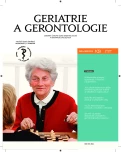Prevention and management of instability and falls in geriatric patients
Authors:
MUDr. Katarína Bielaková; prof. MUDr. Hana Matějovská Kubešová, Ph.D.; prof. MUDr. Pavel Weber, CSc.
Authors‘ workplace:
Klinika interní, geriatrie a praktického lékařství, LF MU a FN Brno
Published in:
Geriatrie a Gerontologie 2014, 3, č. 1: 25-28
Category:
Review Article
Overview
The ability to move freely is an important factor that determines the quality of life of the elderly population. This is one of the most common geriatric problems that threaten independence and self-sufficiency in seniors. Instability with its major consequences – falls – is becoming a major problem in health care. It is associated with increased morbidity and mortality, increasing the economic costs of health care and is one of the reasons for placement in senior long-term care. This issue is closely linked with demographic projections in the Czech Republic, which assumes a gradual increase in the number of elderly people, and that is why it must be given due attention.
Key words:
falls – balance – geriatric patient – risk factors
Sources
1. AGS/BGS 2010: Summary of the updated American Geriatrics Society/British Geriatrics Society clinical practice guideline for prevention of falls in older person. Journal of the American Geriatric Society 2011; 59: 148–157.
2. Mumenthaler M, Bassetti C, Daetwyler Ch: Neurologická diferenciální diagnostika. 1. vyd., Praha 2008: 325–332.
3. Tinetti ME: Preventing falls in elderly persons. NEJM 2003; 348(1): 42–49.
4. Shobha S: Prevention of falls in older patiens. American family physician 2005; 72(1): 81–88.
5. Kalvach Z, Zadák Z, Jirák R a kol.: Geriatrické syndromy a geriatrický pacient. Praha: Grada Publishing 2008: 135–138, 145–152, 168–194.
6. Klán J, Topinková E: Pády a jejich rizikové faktory ve stáří. Česká geriatrická revue 2003; 2: 38–43.
7. Topinková E: Geriatrie pro praxi. Praha: Galén 2005: 44–51.
8. Kalvach Z, Zadák Z, Jirák R a kol.: Geriatrie a gerontologie. 1. vyd. Praha: Grada Publishing 2004: 179–183, 205–222.
9. Hronovská L: Závratě, instabilita, pády ve stáří. Interní medicína pro praxi 2012; 14(12): 470–472.
10. Doporučené postupy České kardiologické společnosti (www.kardio-cz.cz).
11. Kaňovský P: Poruchy chůze a pády ve stáří. Neurologie pro praxi 2003; 1: 21–25.
12. Joint Commission Resources. Prevence pádů ve zdravotnickém zařízení, cesta k dokonalosti a zvyšování kvality. Praha: Grada Publishing 2007: 21–30.
13. Boyé N, Van Lieshout E: The impact of falls in the elderly. Trauma 2013; 15(1): 29–35.
14. Kannus P, Parkkari J: Prevention of hip fracture with hip protectors. Age and Ageing 2006; 35–S2: ii51–ii54 .
15. Woolcott JC, Kathryn J. Richardson, MSc, Matthew O: Meta-analysis of the Impact of 9 Medication Classes on Falls in Elderly Person. Arch Intern Med 2009; 169(21): 1952–1960.
16. Sherrington C, Tiedemann A, Fairhall N: Exercise to prevent falls in older adults: an updated meta-analysis and best practice recommendations. NSW Public Health Bulletin 2011; 22(4): 78–83.
17. Gillespie LD, Robertson MC, Gillespie WJ, et al.: Interventions for preventing falls in older people living in the community. Cochrane Database Syst Rev 2012; CD007146.
18. Cameron ID, Gillespie LD, Robertson MC, Murray GM et al.: Interventions for preventing falls in older people in care facilities and hospitals. Cochrane Database Syst Rev 2012; CD005465.
Labels
Geriatrics General practitioner for adults Orthopaedic prostheticsArticle was published in
Geriatrics and Gerontology

2014 Issue 1
- Metamizole vs. Tramadol in Postoperative Analgesia
- Metamizole at a Glance and in Practice – Effective Non-Opioid Analgesic for All Ages
- Memantine in Dementia Therapy – Current Findings and Possible Future Applications
- What Effect Can Be Expected from Limosilactobacillus reuteri in Mucositis and Peri-Implantitis?
- Memantine Eases Daily Life for Patients and Caregivers
Most read in this issue
- The issue of arterial hypertension in questions and answers
- Specific clinical features of late-onset rheumatoid arthritis
- Prevention and management of instability and falls in geriatric patients
- Home-based care for patients with dementia in the context of burden on non-expert/non-professional caregivers
